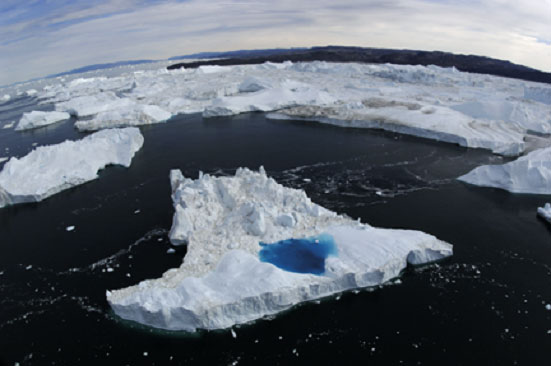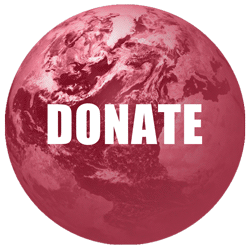 All of the phases of water—solid, liquid and vapor—relate to glacier dynamics. Water has unique qualities that come into play in understanding the roles glaciers play in the Earth system. For example, water expands rapidly when it freezes—an increase of about 9% by volume. Also, water enters the atmosphere through the familiar cycle of melting and evaporation, but water can also enter the atmosphere directly from a solid state through a process known as sublimation. Also, water—the only substance that is lighter in its solid (ice) than its liquid state—has more density as salt water than as fresh water.
All of the phases of water—solid, liquid and vapor—relate to glacier dynamics. Water has unique qualities that come into play in understanding the roles glaciers play in the Earth system. For example, water expands rapidly when it freezes—an increase of about 9% by volume. Also, water enters the atmosphere through the familiar cycle of melting and evaporation, but water can also enter the atmosphere directly from a solid state through a process known as sublimation. Also, water—the only substance that is lighter in its solid (ice) than its liquid state—has more density as salt water than as fresh water.
The melting fresh water from glaciers alters the ocean, not only by directly contributing to the global sea level rise, but also because it pushes down the heavier salt water, thereby changing what scientists call the THC, or Thermo (heat) Haline (salt) Circulation, meaning currents in the ocean. This has an immediate effect on the near region, such as the north Atlantic off the coast of Greenland, but ultimately the impacts can ripple far beyond the immediate area and climate.
Ice that took centuries to develop can vanish in just a few years. A glacier doesn’t melt slowly and steadily like an ice cube on a table. Once glacial ice begins to break down, the interaction of meltwater and sea water with the glacier’s structure can cause increasingly fast melting and retreat. Today, Earth’s surface is made up of 71% water, 10% ice and 19% land. Most of the world’s ice is in the Arctic and Antarctic, but some of it is scattered around Earth in the form of mountain glaciers.
Water not only expands when frozen, but also when heated, and it is estimated that in the 21st century the melting of ice caps and glaciers combined with the thermal expansion of ocean water will cause an average increase of sea level of roughly a meter (a bit more than one yard). That’s an average; in some places it will rise more and in others less, in part because (as we now know through satellite measurements) sea level itself varies, bulging in some places and slumping in others. In Greenland, for example, it is expected that as the ice melts into the ocean the land mass will rebound, in effect “bouncing back” after it was pushed down by the weight of the ice. Sea levels may actually go down in some regions, but rising sea levels will be a critical issue in many other parts of the planet, adversely affecting billions of people in India, Bangladesh and China as well as along the U.S. Gulf and Northwest coasts.
As the planet’s air conditioner, the polar ice caps impact weather and climate dynamics, such as the jet stream. Glaciers are also early indicators of climate changes that will have a somewhat more delayed impact on other parts of the Earth system. Glaciers are sentinels of climate change. They are the most visible evidence of global warming today. In addition to raising sea water levels, widespread loss of glaciers will likely alter climate patterns in other, complex ways. For example, glaciers’ white surfaces reflect the sun’s rays, helping to keep our current climate mild. When glaciers melt, darker exposed surfaces absorb and release heat, raising temperatures. Our way of life is based on climate as we know it.






